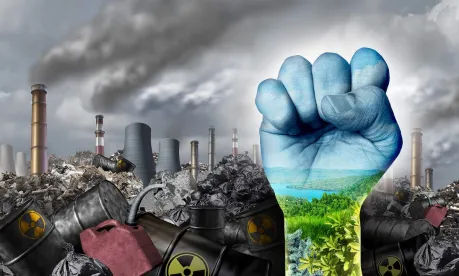Last week marked the conclusion of the 28th Conference of Parties (COP28) to the United Nations Framework Convention on Climate Change (UNFCC) in Dubai, United Arab Emirates (UAE). As we previously discussed, the expectations were COP28 would tackle a range of critical issues toward achieving the climate goals set out in the Paris Agreement. Below is an overview of the most significant developments coming out of Dubai, as reflected in the COP28 agreement, and the expectations for future climate action.
- UAE Consensus. COP28 marked the first “Global Stocktake,” which is intended to identify the status of the global efforts to address climate change in order to inform governments when they assess and update their national goals and actions to achieve the overall objectives of the Paris Agreement. The consensus in Dubai was a recognition that “limiting global warming to 1.5°C with no or limited overshoot requires deep, rapid and sustained reductions in global greenhouse gas emissions of 43 per cent by 2030 and 60 per cent by 2035 relative to the 2019 level and reaching net zero carbon dioxide emissions by 2050.”
As part of the nation-specific planning process, a critical question for COP28 was what is the future of fossil fuels as part of the decision-making heading into 2025, when governments are to establish new Nationally Determined Contributions (NDCs) under the Paris Agreement taking into account the Global Stocktake. There were multiple, competing visions for how fossil fuels should be addressed, including whether any COP28 agreement should call for a “phase down” or a “phase out” of fossil fuels. Other nations called for a focus on the development, use, and scaling up of carbon capture, utilization, and storage (CCUS) and other technologies to reduce the emission of carbon dioxide from traditional fossil fuel-focused industrial sectors. Notably, any agreement would need to be based on consensus (i.e., all 198 nations), and other countries opposed any mention of fossil fuels in any COP28 agreement.
COP28 went into extra innings in an attempt to address this question. With the UAE leading the charge, compromise language was agreed to that calls for “[t]ransitioning away from fossil fuels in energy systems, in a just, orderly and equitable manner, accelerating action in this critical decade, so as to achieve net zero by 2050 . . .” The majority opinion appears to be that the UAE Consensus language is a significant development, given it is the first time an international agreement on climate change specifically addressed the future of fossil fuels. Past UN-led climate agreements have called on nations to reduce greenhouse gas emissions but declined to explicitly mention the words “fossil fuels.” Notably, this agreement is not legally binding. What that means is that it will be up to each country, as part of the process to update their NDCs, to determine how to incorporate, if at all, the COP28 agreement’s call to transition away from fossil fuels.
In the US, we may see this language cited to support state-specific climate change-focused regulatory actions and private-sector actions, including decisions related to financing fossil-fuel-related projects. But oil and gas production in the US, which is largely based on market factors, is at historically high levels, and key geopolitical allies are spending billions on new oil and gas infrastructure, in part to support utilization of US-supplied fossil fuel feedstocks. The meaning and import of the UAE Consensus will likely be the focus of the COP process and nation-specific implementation moving forward.
- Renewable Energy. To effectuate this “transition,” the COP28 agreement calls for “[t]ripling renewable energy capacity globally . . . by 2030.” However, renewable energy faces an increasing number of challenges, including distribution bottlenecks, environmental permitting timelines, third party litigation focused on preventing renewable energy projects, higher interest rates, and continued supply chain disruptions, among other hurdles. As discussed below, this COP28 goal is only possible with a significant increase in financial resources to support renewable projects, which is particularly true for emerging economies. Many African nations at COP28 argued that without outside financial assistance they would need to first utilize available and cost-effective oil and gas resources to become wealthy enough to invest in zero-emission renewable energy resources. The pace of renewable energy investment and development will be a key metric toward the progress of meeting the goals in the Paris Agreement.
- Nuclear Energy. The COP28 agreement specifically calls for accelerating nuclear energy solutions and marks the first time nuclear energy has been formally specified as one of the solutions to climate change in a COP agreement. Furthermore, during COP28, 24 countries backed a Ministerial Declaration calling for the tripling of global nuclear energy capacity by 2050, recognizing that new nuclear technologies could occupy a small land footprint, partner well with renewable energy sources, and have additional flexibilities that support decarbonization beyond the power sector.
- Accelerating Climate Mitigation Technologies. A consensus position at COP28 was the call for the acceleration of zero- and low-emission technologies, including “abatement and removal technologies such as carbon capture and utilization and storage, particularly in hard-to-abate sectors, and low-carbon hydrogen production.” While certain NGOs and a minority of others oppose, for example, carbon capture and utilization and storage (CCUS) and hydrogen production, this is an issue where there is largely consensus at the international, national, and subnational levels, including states as divergent politically as California and Texas. In the US, in part due to the Inflation Reduction Act and similar federal legislation, there is – and will continue to be – significant investment and development into CCUS, hydrogen, and related infrastructure projects.
- Financing. As noted above, the transition from fossil fuels and the scaling of renewable energy projects and climate mitigation technologies is not possible without a significant increase in financing, particularly for transition efforts in developing economies. For example, the COP28 agreement calls for $4.3 trillion per year in global investment in clean energy up until 2030, and then $5 trillion per year up until 2050, in order to meet net zero emissions by 2050; however, the current level of global financing of clean energy projects is $1.8 trillion per year. Consequently, the COP28 agreement calls on multilateral development banks and other financial institutions to scale up investments in climate action and increase the scale of climate finance, while also calling for the reform of such multilateral development banks to accelerate such expansion. The agreement calls on the shareholders of the World Bank and the other multilateral development banks to update the architecture associated with global climate change mitigation-focused investment, with an emphasis on increasing the use of grants and concessional instruments as climate finance tools. The agreement goes on to emphasize the importance of “ . . . central banks, commercial banks, institutional investors and other financial actors with a view to improving the assessment and management of climate-related financial risks, ensuring or enhancing access to climate finance in all geographical regions and sectors, and accelerating the ongoing establishment of new and innovative sources of finance.” Financing climate mitigation and the energy transition will likely continue to be a focal point in future climate negotiations.
- Loss and Damage Fund. A priority heading into Dubai was finalization of the “loss and damage” fund established during COP27, which is a fund to help vulnerable countries – which often contribute less greenhouse gas emissions – to recover and rebuild from climate change-driven damage. There was concern this issue could play a spoiler to achieving further progress at COP28, but on day one an agreement was reached on the loss and damage fund. The key issue remains investment into this fund. Certain nations made large commitments in Dubai (e.g., the UAE and Germany made $100 million contributions), but the fund is meant to be capitalized with at least $100 billion, illustrating the current lack of funding for climate mitigation and climate adaptation and recovery.
- Carbon Markets. Global carbon markets and continuing implementation of Article 6 of the Paris Agreement was another priority agenda item at COP28. During COP26, the overarching rules for Article 6 carbon markets were established, but there are still questions on implementation. For example, for Article 6.2 markets (i.e., trading carbon offsets between countries), there are still questions associated with the process for authorization of emission reduction actions. There are bigger outstanding issues with Article 6.4 markets (i.e., trading carbon offsets involving private and public entities), where the rules, methodologies, and procedures need to be finalized to unlock the potential of a centralized global carbon market to cost-effectively drive down greenhouse gas emissions. Unfortunately, carbon markets and Article 6 was one of the bigger disappointments of COP28, as the negotiations in relation to Articles 6.2 and 6.4 broke down, and no text was able to be agreed for these topics.
While there was lack of progress on Article 6 implementation, the expectation is that we will see countries attempt to implement nation-to-nation trading under Article 6.2. In addition, we expect further developments associated with voluntary carbon markets but with an increase in regulatory scrutiny. For example, California recently enacted Assembly Bill 1305, which focuses on regulating claims associated with the sale and purchase of voluntary carbon offsets, and the US Commodity Futures Trading Commission has proposed guidance regarding the listing for trading of voluntary carbon credit derivative contracts.
The COP moves to Baku, Azerbaijan in 2024, with plenty of issues remaining to be resolved, in particular the role of fossil fuels, how to finance the energy transition – in particular in developing economies – and how to refine the Article 6 framework to maximize the potential of carbon markets. Given that there is increasing public pressure on governments to address climate change and that nations are expected to establish updated Nationally Determined Contributions in 2025 under the Paris Agreement, 2024 promises to be an eventful year in the advancement of the issues central to global climate change and the energy transition.









 />i
/>i

